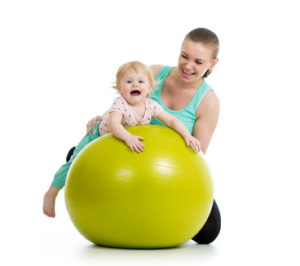Tummy time was one of the first uncomfortable experiences I had to put my baby through. I remember at the one and two week pediatrics appointment being asked – “So how is tummy time going?”
ARE YOU KIDDING ME?
We both went through major surgery last week. I can’t even drive and can barely walk upstairs at night. And you’re asking me about this infant “exercise?”
It’s important, and that’s why the doctors ask, and encourage, and recommend. In the 1990s, the American Academy of Pediatrics instituted their “Back to Sleep” campaign, which drastically decreased the number of sleep related deaths like Sudden Infant Death Syndrome (SIDS). That was an amazing outcome, but they had to make a plan. Unfortunately, newborn babies are in ‘bucket’-like baby containers for much of their day until they start to move. Infant car seats, swings, bouncy seats, rock and plays all keep our newborns from moving. With all of this time on their backs, babies need time in other positions too. For the past 9 months, they’ve been in a flexed (fetal) position, and it’s our job to encourage them to stretch out a little bit!
To start, most babies will hate tummy time.
Especially if they’re on a floor, alone, when they can’t see you. They really can’t see much – at 4 weeks they can only focus at a 12 inch distance, and many babies can’t pick their heads up yet. Think about how they were so cozy safe in the womb, held lovingly in your arms, or tucked carefully in a carrier. Then its time for this “exercise” – lying in a mat struggling to move enough to find out where mama went, turning red and crying. Its painful to watch! During those first few weeks – remember that these positions “count” towards tummy time:
- resting on your chest in an inclined position
- prone (on their belly) on your lap to read a book, or look at a toy
- football hold – (added benefit, this can alleviate some gas pains with added pressure on on the belly)
Tummy time is important for higher level motor control
I am a pediatric occupational therapist and have worked with many children on motor development and related delays. I have seen babies that can’t participate in tummy time for medical reasons, and I treat older kids that struggle with fine motor skills. Tummy time helps babies to develop head and neck control, and to use their eyes in a coordinated manner. When on their tummies, babies begin to build upper body strength and start to segment their bodies to roll over, sit up, and eventually stand. All of these motor skills translate into higher-level patterns like writing, using scissors, and tying shoes. When I get a new student with fine motor delays, its important for me to understand how they tolerated tummy time as infants, how long they spent crawling as well as timeliness of other motor milestones.
Here are some suggestions to make tummy time more enjoyable
1. make it visually stimulating – Tummy time mats are great, but just a blanket on the floor works too. Get down on their level, bring a sibling to play nearby, or coerce your pet to make an appearance. Black and white high contrast board books are very interesting to babies. So are mirrors.
2. prop up – It can help to change the angle for a baby to support himself on the floor. A rolled up blanket or towel under his chest, or a boppy-type pillow offers support.
3. invite some friends – If you join a new parents group or attend any event with other kids on the floor – use it to your advantage. My children tolerated the longest tummy time sessions at the hospital meet-ups, when they could look at all the other babies.
4. ready set roll – Get out that exercise ball. Gently place the baby over the top and get a good hold, and rock back/forth. They love moving in rhythmical patterns, towards your smiling face and beautiful voice. I sang a lot of “row-row-row your boat” doing this one.

5. prepare for takeoff – If you’re not recovering from a caesarean section, get some crunches in here. Lie on your back on the floor and place your baby on your shins, as if to play ‘airplane’ with her. Again, another position for her to be close to you, but a different viewpoint. Prepare to get drooled on!

If it’s still hard, remember to change positions
Think about how much time your baby spends in each position. Try wearing your baby using carriers in different configurations. Be aware of what side you hold him on to feed, and switch it up. Do the same for diaper changes. Alternate which end of the crib she sleeps on for naps. Go outside so your baby can experience the visual contrast of the bare branches against the sky. In a few months when spring is upon us, expose your baby to the sounds of birds chirping. She will turn her head to listen. When it’s warm, get your baby used to the sensation of the grass or sand beneath his body.
Physicians recommend implementing tummy time throughout the day, building up tolerance. Start with 2-3 times a day for a minute, and end on a positive note. It is helpful to build tummy time into a routine, as you would establish a daily rhythm for sleep/eat/play. As the weeks go on and your baby has more motor control, tummy time will come easier. Remember, the discomfort of this stage is temporary, but its benefits are long term.










